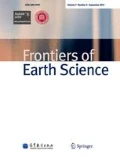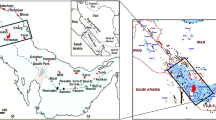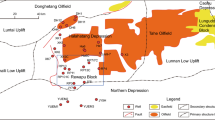Abstract
The ultra-deep Ordovician reservoirs in North Shuntuoguole Oilfield (or Shunbei Oilfield) of Sinopec have achieved annual production of one million ton, and the oil & gas in different faults show different physical properties and fluid phases. In this study, the 28 oil samples from the ultra-deep Ordovician were analyzed using whole oil chromatography. The heptane and isoheptane values of the oil samples were in the range of 29.79%–46.86% and 1.01%–3.06%, respectively, indicating the oils are high mature. The maturity that calculated based on light hydrocarbon values was higher than which calculated by using aromatic hydrocarbon parameters, suggesting the light hydrocarbon maturity mostly reflects the maturity of the late charged hydrocarbon. The 2M-/3M-C5 and 2M-/3M-C6 ratios varied in the ranges of 1.41–1.81 and 0.79–1.09, respectively, and the iC5/nC5 and 3M-C5/nC6 ratios were 0.31–0.90 and 0.16–0.37, respectively, indicating that ultra-deep Ordovician reservoirs have not experienced biodegradation. The Mango parameter K1 of the oil samples ranges 0.96–1.01 except for the oil from Well SB4, which suggests that most of the reservoirs have not suffered thermochemical sulfur reduction (TSR). Meanwhile, the oils have not experienced evaporative fractionation since the toluene/nC7 and nC7/MCC6 ratios range from 0.10–0.38 and 1.50–1.80, respectively. The close correlation between P3 and P2 + N2 and between P2 and N2/P3 indicates that the oils from different faults have the same origin. According to the characteristics of LHs rich in n-alkane, as well as other biomarkers, such as aryl isoprenoids, and aromatic hydrocarbon parameters, the oil originated from the source rock of Lower Cambrian Yu’ ertusi Formation. Meanwhile, the source rocks in different fault zones slightly differed in organic facies.
Similar content being viewed by others
References
Berment W O, Levey R A, Mango F D (1995). The temperature of oil generation as defined with C7 chemistry maturity parameter (2,4-DMP/2,3-DMP ratio)//Organic Geochemistry: development and applications to energy. In: Climate, Environment and Human History: AIGOA. Donostia-San Sebastian: Spain
Cai C, Zhang C, Worden R H, Wang T, Li H, Jiang L, Huang S, Zhang B (2015). Application of sulfur and carbon isotopes to oil-source rock correlation: a case study from the Tazhong area, Tarim Basin, China. Org Geochem, 83–84: 140–152
Cai C, Amrani A, Worden R H, Xiao Q, Wang T, Gvirtzman Z, Li H, Said-Ahmad W, Jia L (2016). Sulfur isotopic compositions of individual organosulfur compounds and their genetic links in the Lower Paleozoic petroleum pools of the Tarim Basin, NW China. Geochim Cosmochim Acta, 182: 88–108
Cao Z, Lu Q, Gu Y, Wu X, You D, Zhu X (2020). Characteristics of Ordovician reservoirs in Shunbei 1 and 5 fault zones, Tarim Basin. Oil Gas Geo, 41(5): 975–984 (in Chinese)
Chai Z, Chen Z, Liu H, Cao Z, Cheng B, Wu Z, Qu J (2020). Light hydrocarbons and diamondoids of light oils in deep reservoirs of Shuntuoguole Low Uplift, Tarim Basin: implication for the evaluation on thermal maturity, secondary alteration and source characteristics. Mar Pet Geol, 117: 104388
Chang X, Wang T, Cheng B, Wang X, Deng B (2014). Geochemical characteristics of light hydrocarbons from the central part of Tabei Uplift and their implications. Nat Gas Geosci, 25(7): 1058–1064 (in Chinese)
Cheng B, Wang T, Chang X (2013). Application of C5–C7 light hydrocarbons in geochemical studies: a case study of Ordovician crude oils from the Halahatang depression, Tabei Uplift. Nat Gas Geosci, 24(2): 398–405 (in Chinese)
Cheng B, Liu H, Cao Z, Wu X, Chen Z (2020). Origin of deep oil accumulations in carbonate reservoirs within the north Tarim Basin: Insights from molecular and isotopic compositions. Org Geochem, 139: 103931
Cheng K, Jin W, He Z (1987). Composition characteristics of light hydrocarbons in continental oil and condensate and their geological significance. Pet Explor Dev, 14(1): 34–43 (in Chinese)
Harris S A, Whiticar M J, Flower M G (2003). Classification of Duvernay sourced oils from central and southern Alberta using compound specific isotope correlation (CSIC). Bull Can Pet Geol, 51(2): 99–125
He T, Lu S, Li W, Sun D, Pan W, Zhang B, Tan Z, Ying J. (2020). Paleoweathering, hydrothermal activity and organic matter enrichment during the formation of earliest Cambrian black strata in the northwest Tarim Basin, China. J Petrol Sci Eng, 189: 106987
He T, Li W, Lu S, Pan W, Ying J, Zhu P, Yang E, Wang X, Zhang B, Sun D (2022). Mechanism and geological significance of anomalous negative δ13Ckerogen in the Lower Cambrian, NW Tarim Basin, China. J Petrol Sci Eng, 208: 109384
Hu T, Ge B, Zhang Y, Liu B (1990). The development and application of fingerprint parameters for hydrocarbons absorbed by source rocks and light hydrocarbons in natural gas. Experiment Petrol Geo, 12(4): 375–395 (in Chinese)
Huang H, Zhang S, Su J (2016). Palaeozoic oil-source correlation in the Tarim Basin, NW China: a review. Org Geochem, 94: 32–46
Hunt J M (1984). Generation and migration of light hydrocarbons. Science, 226(4680): 1265–1270
Jiao F (2018). Significance and prospect of ultra-deep carbonate fault-karst reservoirs in Shunbei area, Tarim Basin. Oil Gas Geo, 39(2): 207–216 (in Chinese)
Larter S R, Wilhelms A, Head I, Koopmans M, Aplin A, Di Primio R, Zwach C, Erdmann M, Telnaes N (2003). The controls on the composition of biodegraded oils in the deep subsurface. Part 1: biodegradation rates in petroleum reservoirs. Org Geochem, 34(4): 601–613
Leythaesuer D, Schaefer R G, Weiner B (1979). Generation of low molecular weight hydrocarbons from organic matter in source beds as a function of temperature and facies. Chem Geol, 25(1–2): 95–108
Lin R, Zhang M (1998). Compositional characteristics of light hydrocarbons and their genetic types of crude oils in the Tarim Basin. Geol Rev, 42(Supp): 26–30 (in Chinese)
Liu B (2020). Analysis of main controlling factors of oil and gas differential accumulation in Shunbei area, Tarim Basin-taking Shunbei No.1 and No. 5 strike slip fault zones as examples. Chin Petrol Explor, 25(3): 83–95 (in Chinese)
Ma A, Jin Z, Zhu C, Bai Z (2017). Cracking and thermal maturity of Ordovician oils from Tahe Oilfield, Tarim Basin, NW China. J Nat Gas Geosci, 2(4): 239–252
Ma A, Jin Z, Zhu C, Gu Y (2018). Detection and significance of higher thiadiamondoids and diamondoidthiols in oil from the Zhongshen 1C well of the Tarim Basin, NW China. Sci China Earth Sci, 61(10): 1440–1450
Ma A, Jin Z, Li H, Gu Y, Qiu N, Zhu X, Wu X, Yang X, Wang S (2020). Secondary alteration and preservation of ultra-deep Ordovician oil reservoirs of North Shuntuoguole area of Tarim Basin, NW China. Earth Sci, 45(5): 1737–1753 (in Chinese)
Ma A, Lin H, Yun L, Cao Z, Zhu X, Li W, Wu X (2021). Diamondoids in oils from ultra-deep Ordovician in the north Shuntuoguole area in Tarim Basin, NW China. J Nat Gas Geosci, 6(2): 89–99
Mango F D (1987). An invariance in the isoheptanes of petroleum. Science, 237(4814): 514–517
Mango F D (1990). The origin of light hydrocarbons in petroleum: a kinetic test of the steady-state catalytic hypothesis. Geochim Cosmochim Acta, 54(5): 1315–1323
Mango F D (1992). Transition metal catalysis in the generation of petroleum: a genetic anomaly in Ordovician oils. Geochim Cosmochim Acta, 56(10): 3851–3854
Mango F D (1997). The light hydrocarbons in petroleum: a critical review. Org Geochem, 26(7–8): 417–440
Peters K E, Walters C C, Moldowan J M (2005). The Biomarker Guide. Cambridge: Cambridge University Press
Qi L (2020). Characteristics and inspiration of ultra-deep fault-karst reservoir in the Shunbei area of the Tarim Basin. Chin Petrol Explor, 25(1): 102–111 (in Chinese)
Song D, Wang T G, Deng W, Shi S (2016). Application of light hydrocarbons (C5-C7) in Paleozoic marine petroleum of the Tarim Basin, NW China. J Petrol Sci Eng, 140: 57–63
Song D, Zhang C, Li S, Wang T G, Li M (2017). Elevated Mango’s K1 values resulting from thermochemical sulfate reduction within the Tazhong oils, Tarim Basin. Energ Fuel, 31(2): 1250–1258
Snowdon L R, Powell T G (1982). Immature oil and condensate-modification of hydrocarbon generation model for terrestrial organic matter. AAPG Bull, 66(6): 775–788
Sun X, Wang Y, Liu Z, Dong Z, Xiao Q (2013). Effects of natural evaporation on C5-C8 light hydrocarbon indicators: evidence from experimental results in the laboratory. Acta Petrol Sin, 34(6): 1060–1069 (in Chinese)
Sun Y, Xu S, Lu H, Cuai P (2003). Source facies of the Paleozoic petroleum systems in the Tabei uplift, Tarim Basin, NW China: implications from aryl isoprenoids in crude oils. Org Geochem, 34(4): 629–634
Thompson K F M (1979). Light hydrocarbons in subsurface sediments. Geochim Cosmochim Acta, 43(5): 657–672
Thompson K F M (1983). Classification and thermal history of petroleum based on light hydrocarbons. Geochim Cosmochim Acta, 47(2): 303–316
Thompson K F M (1987). Fractionated aromatic petroleum and the generation of gas condensates. Org Geochem, 11(6): 573–590
Thompson K F M (1988). Gas-condensate migration and oil fractionation in deltaic system. Mar Pet Geol, 5(3): 237–246
Thompson K F M (2010). Aspects of petroleum basin evolution due to gas advection and evaporative fractionation. Org Geochem, 41(4): 370–385
Tissot B P, Welte D H (1984). Petroleum Formation and Occurrence. London: Springer-Verlag
Walters C C, Isaksen G H, Peters K E (2003). Applications of light hydrocarbon molecular and isotopic compositions in oil and gas exploration. In: Hsu C S, ed. Analytical Advances for Hydrocarbon Research. Modern Analytical Chemistry. Boston: Springer
Wang P, Zhang D, Xiao T, Song F, Cai B (2005). Geochemical characteristics of the light hydrocarbons in Jianghan Basin, China. Pet Explor Dev, 32(3): 45–47 (in Chinese)
Wang P, Xu G, Zhang D, Xiao T, Ren D (2010). Problems with application of heptane and isoheptane values as light hydrocarbon parameters. Pet Explor Dev, 37(1): 121–128 (in Chinese)
Wang Q, Hao F, Cao Z, Tian J, Cong F (2021). Geochemistry and origin of the ultra-deep Ordovician oils in the Shunbei Field, Tarim Basin, China: implications on alteration and mixing. Mar Pet Geol, 123: 104725
Welte D H, Kratochvil H, Rulkötter J, Lawein H, Schaefer R G (1982). Organic geochemistry of crude oils from the Vienna Basin and an assessment of their origin. Chem Geol, 35(1–2): 33–68
Worden R H, Smallwy P C, Oxtoby N H (1995). Gas souring by thermochemical sulfate reduction at 140°C. AAPG Bull, 79(6): 854–863
Xiao Q, Sun Y, Mao S, Wan Y (2011). Geochemical characterization of light hydrocarbons and its controlling factors in Carboniferous crude oils from the TZ4 Oilfield, Tarim Basin, NW China. Acta Petrol Sin, 32(2): 206–211 (in Chinese)
Yang H, Deng X, Zhang Y, Xie Z, Li Y, Li S, Zhang H, Zhu Y, Chen Y (2020). Great discovery and its significance of exploration for Ordovician ultra-deep fault-controlled carbonate reservoirs of Well Manshen 1 in Tarim Basin. Chin Petrol Exoplor, 25(3): 13–23
Yang L, Zhang C, Li M, Du J (2015). Influence of slight biodegradation on C7 hydrocarbons in crude oils: a case study of Dawanqi Oilfeld in Tarim Basin. Geochimica, 44(5): 485–492 (in Chinese)
Zhang M, Zhang J, Zhang C (1999). Geochemical characteristics of light hydrocarbons for crude oils in Tarim Basin. Geochimica, 28(3): 191–196 (in Chinese)
Zhang S, Hanson A D, Moldowan J M, Graham S A, Liang D, Chang E, Fago F (2000). Paleozoic oil-source rock correlations in the Tarim Basin, NW China. Org Geochem, 31(4): 273–286
Zhang S, Huang H, Xiao Z, Liang D (2005). Geochemistry of Palaeozoic marine petroleum from the Tarim Basin, NW China. Part 2: maturity assessment. Org Geochem, 36(8): 1215–1225
Zhang S, Jin S, Wang X, Zhu G, Yang H, Liu K, Li Z (2011). Geochemistry of Paleozoic marine petroleum from the Tarim Basin, NW China. Part 3: thermal cracking of liquid hydrocarbons and gas washing as the major mechanisms for deep gas condensate accumulations. Org Geochem, 42(11): 1394–1410
Zhang S, Huang H, Su J, Zhu G, Wang X, Larter S (2014). Geochemistry of Paleozoic marine oils from the Tarim Basin, NW China.Part 4: paleobiodegradation and oil charge mixing. Org Geochem, 67: 41–57
Zhu Y, Zhang C (1999). Application of Mango’s light hydrocarbon parameters in classification of oils from Tarim Basin. Geochimica, 28(1): 26–33 (in Chinese)
Acknowledgments
This research was supported by the National Natural Science Foundation of China (Grant Nos. 41772153, U19B6003), and Sinopec Division of Science and Technology (Nos. P19024-4, P21085-8). The authors would like to thank three anonymous reviewers for their constructive comments on the manuscript, which improved the scientific clarity.
Author information
Authors and Affiliations
Corresponding author
Rights and permissions
About this article
Cite this article
Dong, L., Ma, A., Lin, H. et al. Characteristics and geochemical implications of light hydrocarbons from ultra-deep Ordovician oils in the North Shuntuoguole area, Tarim Basin. Front. Earth Sci. 16, 623–634 (2022). https://doi.org/10.1007/s11707-021-0953-2
Received:
Accepted:
Published:
Issue Date:
DOI: https://doi.org/10.1007/s11707-021-0953-2




